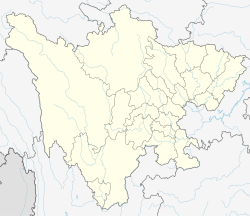Sanxingdui Museum
 | |
| Location | Guanghan City, Sichuan |
|---|---|
| Coordinates | 31°00′11″N 104°13′05″E / 31.00308°N 104.21814°E |
| Website | http://www.sxd.cn/page/default.asp |
The Sanxingdui Museum is located in the northeast corner of the ruins of Sanxingdui, which is at the bank of Duck River in the west of Guanghan City, Sichuan Province, known as a famous historical and cultural city. It is 38 kilometers north from Chengdu and 26 kilometers south from Deyang. It is a large modern thematic museum. The foundation of the museum was laid in August 1992 and it was formally opened to the public in October 1997.[1] [2]
Exhibition halls
Sanxingdui Museum covers an area of about 33 hectares of which the afforested area is over 80%. There are two exhibition halls in the museum, including the First Exhibition Hall and the Second Exhibition Hall. The display area is nearly 12000 square meters. The First Exhibition Hall exhibits gold, copper, jade, stone, pottery, etc. while the Second Exhibition Hall is specially used to exhibit bronze.
Influence
Since the establishment and opening of the museum, it has received more than three million visitors at home and abroad.[citation needed] Even many state leaders have been there including Jiang Zemin and Hu Jintao.[citation needed] The Sanxingdui cultural relics have been presented in Switzerland, Germany, England, Denmark, America, Japan, Australia, France and so on since 1993 and aroused great amazement wherever they appear.[citation needed]

